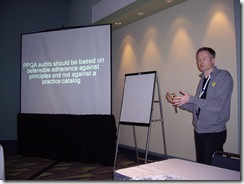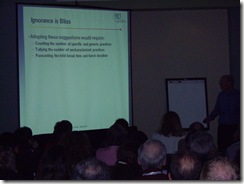With yesterday being the "tutorial day" ahead of the conference, today was the official kick-off day of the conference sessions.
Morning started off in a laid-back way. Even better than sleeping until 7am was having breakfast with Pat O’Toole, Just a never-ending fount of wisdom and experience. Truly, if I ever needed an injection of fresh ideas for my practice, I’d start with him. We are all blessed with different advantages, one (or two?) of Pat’s is having two brothers who are both behavioral psychologists from whom he siphons oodles (technical term) of techniques.
 After missing the plenary sessions, my first attended session was David Anderson’s CMMI Through a Lean Lens. Excellent stuff! What I enjoyed most about it was how easily and convincingly one can see the benefits and accessibility of high maturity behavior with very little data and no artificial, convoluted process models. Nothing more than a few simple development "states" and a calendar. The richness of something as simple as a cumulative flow diagram was very well presented and, I believe, quickly grasped by the audience.
After missing the plenary sessions, my first attended session was David Anderson’s CMMI Through a Lean Lens. Excellent stuff! What I enjoyed most about it was how easily and convincingly one can see the benefits and accessibility of high maturity behavior with very little data and no artificial, convoluted process models. Nothing more than a few simple development "states" and a calendar. The richness of something as simple as a cumulative flow diagram was very well presented and, I believe, quickly grasped by the audience.
David had some suggestions for CMMI v2.0 to accommodate "continuous flow" instead of "transactional processes". He also suggested that continuous flow lent itself more to perceiving development as a service rather than a discrete project effort. It was very telling (to me) how eager the audience is growing over just a couple of years for this sort of data that they were raptly engaged in David’s content and seemed unconcerned for over-staying the room’s allocated time for his talk.
Next up was Judah Mogilensky’s proposal for a new CMMI process area called Fantasy Development. He started out with a brief overview of an earlier proposed process area, Blame Allocation, which has strong strategic ties to the Fantasy Development process area. Of many, one priceless anecdote was, "What’s with all this stuff about managing requirements and planning, and measuring progress? Why can’t CMMI have anything in it that we actually do?!?!"
Sadly, he’s not joking. He’s heard this before as have I. Not realizing what they’re admitting, people who don’t understand CMMI are missing the connection between CMMI and their real work. Unfortunately, whether they admit it or not, many organizations have very well-established and highly productive processes for allocating blame and developing fantasies for which Judah’s proposed PAs are meant to help improve.
As with earlier incarnations of these proposals, Judah made an important point: any area of work important to an organization can be improved with and measured against improvement practices and goals of their own creation. Nothing says CMMI must be the only source of improvement ideas.
Since he would be leaving later in the day, I spent a while after lunch with David to discuss ideas on lean and CMMI. It’s becoming clear that the world cannot wait for SEI or annual LSSC events to bring these topics together. There’s just too much synergy, both in terms of maturing organizational processes (from both a CMMI and non-CMMI perspective) and in terms of affecting culture and behavior that enables and promotes the quantification of these improvements.
Something I observed on the Savannah River on my way back to my hotel was blissfully (in a geeky way) appropriate for discussing continuous flow with David. (Watch the video if you’re interested in that.) He came to the same conclusion as I did, and, it was exactly what the deck hand on the ferry said happens in such situations.
David and I went to see Pat O’Toole’s session on "Maturity Level 4 Results in a Lot of BS." Never at a loss for a compelling title, Pat’s topic had to do with behavior, not what you might think. His example walked through 10 behaviors of high maturity teams that were exhibited by an appraisal team by the mere tracking and projecting of time during a particular appraisal task near the end of an appraisal. His example (masterfully, of course) demonstrated simple measurement and analysis traits with profound effects on both performance and behavior while they were being tabulated in real time. It was like watching magic. Not in the "unbelievable" sense, but in the "pure beauty of simplicity" sense. David and I made quick note that Pat would be a must in any sort of Lean-CMMI event.
His example walked through 10 behaviors of high maturity teams that were exhibited by an appraisal team by the mere tracking and projecting of time during a particular appraisal task near the end of an appraisal. His example (masterfully, of course) demonstrated simple measurement and analysis traits with profound effects on both performance and behavior while they were being tabulated in real time. It was like watching magic. Not in the "unbelievable" sense, but in the "pure beauty of simplicity" sense. David and I made quick note that Pat would be a must in any sort of Lean-CMMI event.
The conference gala reception ended the official activities. The simple movie-theater theme included rooms where two modern films shot in Savannah were playing: Forrest Gump, and Midnight in the Garden of Good and Evil, and a movie-style.concession stand full of popcorn, candy bars, nachos & cheese and Cracker Jack.
Not all rosy
Although I led the reviewer group for agile content for this year’s conference, I was not able to commit to attending all the agile-related presentations. So I am making it a point to query people attending these sessions for their immediate reactions. Reports from several people about presentations and tutorial content on "agile" topics is revealing a disappointing condition. Namely, that the "dark side" of the force is still strong in much of the content people are communicating. Several manifestations are cropping up including poor understanding of true "agility" and "lean" concepts and practices, re-purposing traditional approaches but calling them "agile" or "lean" by merely eliminating the obvious waste, and diluting the benefits of CMMI to enable achievement of ratings by teams using agile.
What’s most disappointing is that this content is supposedly the "best" of the crop of submitted abstracts which tells me that we need a better topic submission and review process. Namely, that what we ask for when proposing topics needs to be improved, and, how we review the proposals needs to be changed. A few years ago, the conference committee attempted an overall broad-based improvement for similar reasons but only came up with increasing the word-count on abstracts and asking for "take-aways" for each proposal. I guess this falls under the category of, "just because a little isn’t good, doesn’t mean more is better."
We need a better process. I’ll be providing that feedback at tomorrow’s conference retrospective.
Day’s Conclusion
One thing was abundantly clear from today: I was being given glimpses of the same idea over and over from many facets. That idea was about behavior. Behavior is central to improvement. End of discussion.
Culture will follow behavior, whether good or bad. People’s responses to input will be manifested in their behavior and that will be in response to the stimulus. I’ve known the central criticality of behavior in the continuum of improvement. However, the key "nugget" for me today was that it’s surprisingly simple to influence behavior in positive, productive, value-added ways. And, it’s also not as hard as we might think to turn "bad" behavior around with similarly simple, yet powerful examples of the benefits we want when we conduct ourselves with the behaviors that achieve them.
My conversation with Pat at breakfast, David’s cumulative flow diagram, Judah’s tongue-in-cheek process areas, the port’s fast clearing of their container backlog, Pat’s "BS" presentation, and other side-conversations I won’t detail here, all orbited on this one theme: behavior and how we affect it is the future of business performance improvement and we’d better get on that ferry right now.


 After missing the plenary sessions, my first attended session was
After missing the plenary sessions, my first attended session was 


